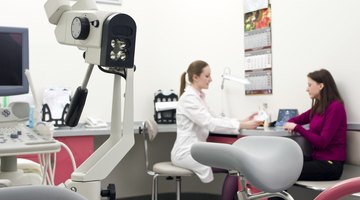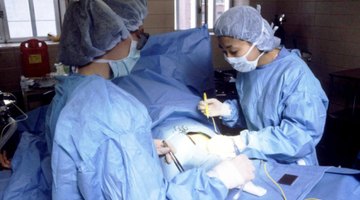Headache After C-Section
In the United States, doctors deliver 32 percent of babies -- nearly one out of every three births -- through cesarean deliveries, according to 2007 data from the Centers for Disease Control and Prevention. As a form of surgery, cesarean deliveries -- commonly called C-sections -- can result in various side effects and complications, including headaches.
The Facts
A cesarean delivery occurs when your obstetrician delivers your baby through an incision in your abdominal wall and uterus. The average C-section takes approximately 45 minutes, with delivery usually during the first 15 minutes of the surgery, according to the American Pregnancy Association. Before the procedure, your doctor numbs your body with anesthesia. Most women get pain relief through an epidural or a spinal block, two forms of regional anesthesia that involve numbing of the nerves in your back to reduce pain sensation in the lower half of your body.
Causes

Epidural Side Effects and Risks
Learn More
Developing a headache after a C-section is often a side effect of regional anesthesia. Referred to as a spinal headache, this condition develops in one of every 100 deliveries, according to Dr. Glade Curtis, obstetrician and coauthor of “Bouncing Back after Your Pregnancy.” During the anesthesia procedure, the anesthesiologist inserts a needle into your spinal area in preparation for administering the pain medication. In certain situations, when the needle enters the epidural or subarachnoid space near the spinal cord, it accidentally punctures the covering of the spinal cord. This leads to spinal fluid seepage into the cavities surrounding the spinal cord and can cause post-surgery headaches.
Symptoms
Headaches following a C-section vary in severity from a mild throbbing to a severe, pounding head pain. Spinal headaches typically worsen when you’re standing, walking or sitting in an upright position. Other symptoms that may accompany C-section headaches include nausea, an upset stomach and vomiting. Tell your obstetrician right away if you experience a severe headache after a cesarean delivery, especially if you suffer from other symptoms. This could indicate a severely punctured spinal cord or other potentially serious complications.
Treatment

Common Side Effects on Legs After an Epidural
Learn More
In most cases, time, rest and oral pain medication are the only treatment measures necessary to get rid of a spinal headache that develops after a C-section. Consult your doctor before taking any oral pain medication, especially if you’re nursing. In certain situations, your doctor may need to seal off the punctured spinal cord with an epidural blood patch. During this procedure, the doctor draws blood from your arm and inserts it into the spinal canal, where it clots and seals the opening in the spinal cord.
Related Articles
- Center for Disease Control and Prevention: Recent Trends for Cesarean Delivery in the U.S.
- “Bouncing Back after Your Pregnancy”; Dr. Glade Curtis and Judith Schuler; 2002











